Low-speed Electric Vehicles: An Underappreciated Threat to Gasoline Demand in China and Global Oil Prices?

Table of Contents
Author(s)
Share this Publication
- Download PDF
- Print This Publication
- Cite This Publication Copy Citation
Collins, Gabriel. 2019. Low-Speed Electric Vehicles: An Underappreciated Threat to Gasoline Demand in China and Global Oil Prices? Issue brief no. 05.15.19. Rice University’s Baker Institute for Public Policy, Houston, Texas.
Disruptive innovation is typically a Silicon Valley buzzword and not one commonly associated with discussions of gasoline markets.1 Yet the past several years in China have seen the emergence of a potential disruptor: low-speed electric vehicles (LSEVs or 低速电动车). These little vehicles typically lack the aesthetic appeal of a Tesla, but they protect drivers from the elements better than a motorcycle, are faster than a bicycle or e-bike, are easy to park and charge, and perhaps most endearing to emerging consumers, can be purchased for as little as $3,000 (and in some cases, less).2 In light of China’s importance to global oil markets, this analysis explores the role LSEVs could play in reducing the country’s gasoline demand growth.
The International Energy Agency (IEA) estimated China’s LSEV fleet at 4 million vehicles as of midyear 2018.3 While small, this already equals about 2% of China’s passenger cars. LSEV sales in China appear to have slowed in 2018, but LSEV manufacturers still sold nearly 1.5 million vehicles, roughly 30% more units than conventional electric vehicle (EV) makers did.4 Depending on how proposed government regulations of the sector unfold in 2019 and beyond, sales could rise significantly as LSEVs penetrate deeper into lower-tier markets where motorcycles and bicycles remain the prevalent means of transport, as well as into the increasingly crowded urban areas where space is at a premium and many residents still cannot afford larger vehicles (Figure 1).
Figure 1 — LSEVs Manufactured in Shandong, China, and Nationwide LSEV Sales
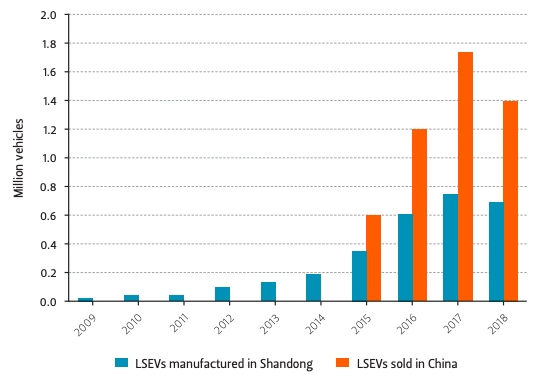
China’s LSEV makers are producing potentially momentous changes on at least two accounts. First, as Chadresekar Iyer of Tata Consultancy Services puts it, their primary market is the “nonconsumer” of cars—the “people in rural China who have never owned one” and who value affordability, accessibility, and simplicity first and foremost.5 China’s rural population exceeded 550 million people last year (roughly the combined populations of the U.S. and Brazil), many of whom do not yet own a four-wheeled personal vehicle.
If nonconsumers choose an EV as their first car, there is a good chance they will stay electric for the long term, which eliminates a source of gasoline demand growth that otherwise would have occurred if they had instead upgraded to a gasoline-powered car. LSEVs also have the benefit of being able to charge from home electrical outlets, eliminating the need to use gas stations that may be far away, as well as the need to invest in the expensive specialty home chargers that larger EVs with higher capacity lithium ion batteries generally require.
LSEVs have only been sold at scale—meaning 1 million plus units per year—for a few years, so it is not yet clear whether their owners will eventually upgrade to larger vehicles that use gasoline. But if these golf-cart-sized machines help condition their owners to prefer electric propulsion and become an item that consumers stick with long-term, the gasoline demand consequences could be significant. When consumers step up from motorcycles to a gasoline-powered car, their personal oil usage will likely jump by nearly an order of magnitude or more. For those who use bicycles or e-bikes, the jump in personal petroleum consumption would be even more significant (Figure 2).
Figure 2 — Est. Annual Fuel Use of Various Vehicle Types
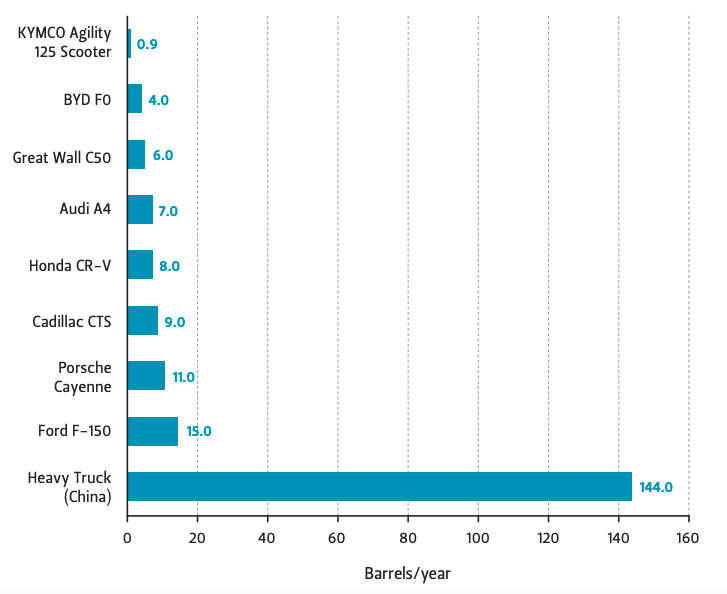
Note Examples listed represent “typical” passenger vehicles types commonly sold in China.
For perspective, if a million LSEVs displaced a million gasoline-powered midsize sedans from the market, about 15,000 barrels per day (bpd) of gasoline demand could effectively be lost. At the current estimated LSEV fleet size, the potential fuel demand displacement could exceed 60,000 bpd—2% of current total Chinese gasoline demand. LSEVs (and other electric vehicles) are even more impactful when it comes to capturing incremental demand for transport services that might otherwise be served by gasoline-burning motors. Here, 4 million LSEVs could capture an amount of incremental gasoline usage equivalent to the nearly 64,000 bpd of gasoline demand growth in China between 2016 and 2017.9
Second, on the back of this massive potential market, LSEVs are already being sold at a globally meaningful scale. Unlike Tesla, which after a decade in business still struggles to scale its production, LSEV makers likely sold about 1.5 million units in China during 2018—equal to about 6% of “conventional” vehicle sales for the year. For a bit of perspective, the entire global sales volume of standard-sized EVs was about 2 million units in 2018.10
How LSEVs May Factor in Gasoline Demand Shifts in China
China’s diesel demand has plateaued, leaving gasoline as the largest single consumption stream that continues to grow.11 China’s gasoline demand already exceeds the total oil products consumption of all but eight countries, and it equals the entire daily oil products consumption of Brazil (based on 2017 BP Statistical Review data).12 However, the relative growth rate appears to be slowing significantly. As a result, the question arises: could disruptive penetration by LSEVs that often use lead-acid batteries, as well as lithium ion-powered mini-EVs that are higher quality and more capable but still relatively inexpensive, create a situation where China’s passenger car fleet is no longer a reliable global crude oil demand driver?
Gasoline demand growth in China is decoupling from the growth of car fleets. Between 2012 and 2018, the country’s private vehicle fleet (mostly composed of cars) grew by nearly 150% while gasoline demand rose by 50%. However, this robust overall growth masked a slowdown during the tail end of that time period. From 2016 to 2018, the country’s car fleet still grew significantly—by 28%—but gasoline use only rose by 6% (Figure 3).
Figure 3 — China’s Gasoline Demand vs. Private Vehicle Fleet Size
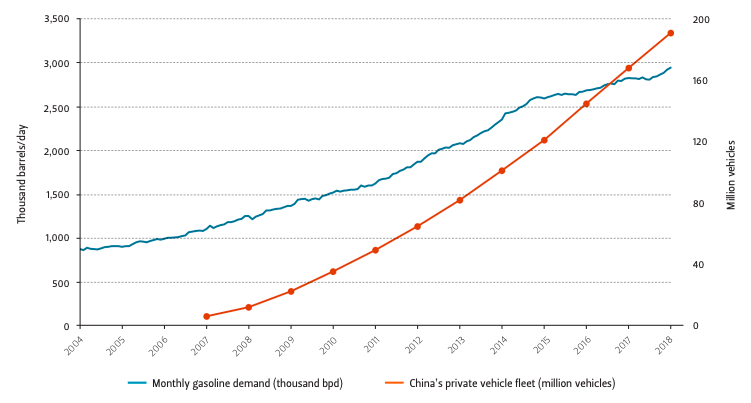
Note 2018 vehicle fleet value is an estimate.
Such dramatic changes were not expected by many market observers. For instance, as late as November 2015, analysts at Credit Suisse, a major global bank, forecasted that China’s gasoline demand would grow by 280,000 to 360,000 bpd in both 2016 and 2017, but the actual increase was 298,000 bpd in 2016 and only 130,000 bpd in 2017.13 This could play a pivotal role in either further eroding gasoline demand growth—or if adoption falters—potentially catalyzing higher-than-expected increases in gasoline use.
The Risk of LSEVs for Gasoline Demand Growth
Multiple studies conducted in China indicate that the purchase cost of a car is often the single most powerful factor driving a buyer’s decision-making.14 Economic concerns can thus overpower other preferences—an important fact to consider since some data suggest that EVs may not be the first choice for many drivers unless the selection is prompted by strong and unavoidable economic motivations, like exemptions from massive license plate and car registration fees. For example, a recent study in China suggests that only 24% of prospective car buyers surveyed in Beijing actually preferred electric cars to gasoline-powered ones.15 This study further reported that only 35% of those surveyed in Shanghai favored electric vehicles.16 In such an environment, the low cost of LSEVs and their slightly more sophisticated mini-EV cousins (essentially Smart Car lookalikes with lithium-ion batteries) can powerfully influence first-time car buyers’ vehicle selections.
Tighter regulations could curtail LSEV sales as the government attempts to uphold safety standards, among other things. Yet LSEVs have already left an indelible mark on the Chinese auto market and likely the country’s gasoline demand growth prospects. This impact stems from a reality summed up neatly in a December 2018 article on China’s EV marketplace by Chandrasekar Iyer, who wrote that “disruptive innovations succeed by transforming complicated and expensive products into simple and affordable ones, thereby enabling a much larger population to benefit from the offerings.”17
In other words, Chinese consumers do not necessarily need a large, expensive EV that costs more than many annual salaries in order to eliminate gasoline from their driving. Rather, they can spend an affordable amount and still access a degree of transportation services, comfort, and practical usability that far exceeds what a motorcycle or electric bike could offer.
Consider that a Tesla Model 3 costs a 407,000 yuan ($61,000), a Yogomo E-Cheng mini-EV costs 153,000 yuan ($23,000), and a true LSEV costs closer to $5,000 to $10,000.18 Such price point disparities place higherend EVs on the wrong end of a key law of marketing physics, which is that companies can easily improve products and raise prices but generally find it much harder to produce simpler, cheaper, and less capable versions of their core products.19 Yet incumbent manufacturers of conventional-sized EVs now find themselves squarely facing this dilemma, as exemplified by a recent McKinsey report that advocates for “de-contenting,” or significantly reducing trim and features, in order to keep sticker prices lower and make EV manufacturing profitable.20
Being positioned on the favorable side of the upward mobility curve does not guarantee LSEVs will disrupt the market, but it enhances their potential to do so, particularly as China’s central government slashes subsidy benefits for many types of larger EVs. There is clearly a strong reservoir of demand for LSEVs in China. Sales of LSEVs have grown robustly without any subsidies at all, despite years of opposition from large incumbent automakers such as Changan Automobile Group, where an executive told Reuters in 2012 that “these cars are illegal, unsafe, and shouldn’t be on the road.”21 LSEV sales even expanded despite government campaigns that sought to reign in their sale and use due to safety concerns beginning in 2017. It is also possible—though not proven—that incumbent automakers in China have sought to limit LSEV growth out of fear that the smaller vehicles were capturing their sales opportunities in high-growth, lower-tier markets.
Gasoline and Crude Oil Market Implications of LSEVs and Mini-EVs
Many key Chinese car markets are now approaching—and sometimes exceeding—the private car ownership rate in New York City, a wealthy place with more than a century of significant personal vehicle ownership history (Figure 4).22 This naturally raises the question of whether certain markets in China are approaching car ownership saturation.
Figure 4 — Key Chinese Cities Now Have Private Car Ownership Rates Approaching—and Sometimes Exceeding—New York City’s
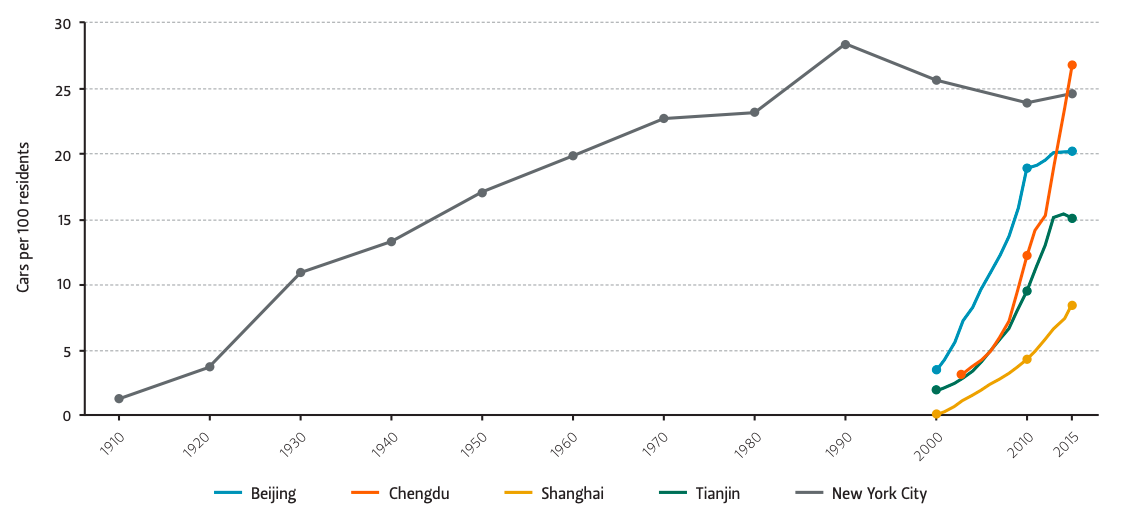
Notes The high car ownership rates in certain parts of China are striking given that China’s urban planning philosophy encourages high-density habitation, which generally works against car ownership. Beijing’s car ownership reached a level in 10 years that took 50 years to attain in New York City. Even adjusting for the newness of personal cars as a transportation method, Beijing’s ownership rate between 2000 and 2010 likely still grew faster than New York City’s from 1910–1960.
Gasoline demand under such a scenario would become much more dependent on car utilization than it is now, with raw fleet growth still providing impetus for increases in gasoline consumption. If vehicle miles travelled become the prime mover of gasoline demand, the growth trajectory would likely flatten even more than it has in the past three years. Consider vehicle use data from Beijing, China’s premier car city, where fleetwide vehicle miles travelled has probably decreased since 2004, even when adjusted for the rise of multivehicle households (Figure 5). In a stagnant utilization environment, gasoline demand becomes even more exposed to potential demand disruptors such as LSEVs.
Figure 5 — Kilometers Driven per Year in Beijing
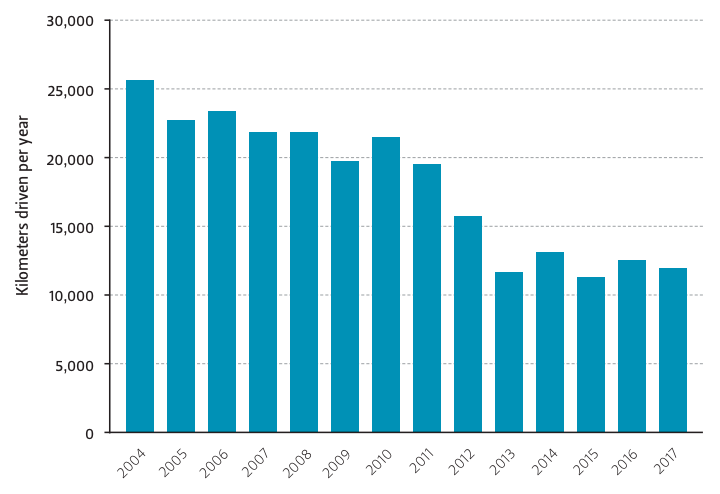
Note Average number of survey respondents = 946.
To give a sense of how greater EV penetration might be weighted relative to lower per capita vehicle usage, a million midsize sedans that each drive 20,000 km annually would consume about 25,000 bpd of gasoline on average.23 Thus, if cars are driven 25% less because owners are sick of sitting in traffic jams, that would take the demand down to about 19,000 bpd of gasoline for the million sedans—a decline of about 6,000 bpd relative to the assumed baseline. However, LSEVs and mini-EVs have a much greater impact: each one that enters the fleet potentially means that a driver will never buy the gasoline-consuming vehicle they might have otherwise purchased, and therefore may be foregoing years of gasoline use.
China’s sales of standard-sized EVs appear to be driven by a handful of larger cities. Data from the Beijing Institute of Technology indicate that from January through October of 2018, 10 key municipal markets accounted for 27% of all plugin battery electric passenger cars sold in China.24 The five largest markets in this sample of 10 cities accounted for nearly 20% of national plug-in EV sales for the first 10 months of 2018.25
China’s LSEV story, however, is not one of large metropolitan areas but rather blue-collar suburbs, central Chinese farms, and coal towns. Leading Chinese LSEV and mini-EV manufacturers are setting their sights on exactly such locales. In January 2019, I mapped the existing dealerships of LinkTour, a major emerging Chinese miniEV seller and found that its dealerships disproportionately targeted Tier 3 through Tier 6 cities—precisely the opposite of the geography that Tesla, NIO, and other large EV makers are going after (Figure 6). For reference, China’s Tier 1 cities are a select group of prosperous coastal enclaves such as Beijing and Shanghai, Tier 2 cities are large provincial centers such as Dalian, and Tier 3 cities are cities such as Zibo and Baotou, which are still often major regional players.26 Even Tier 4, 5, and 6 cities are populous, economically important, and often satellites of larger, higher-tier municipalities. Approximating the Chinese system into the U.S. context, Houston would be a Tier 1 city, Sugar Land and The Woodlands would be Tier 3 cities, and Galveston and Conroe would be Tier 4 or 5 cities.
Figure 6 — Linktour Mini-EV/LSEV Dealerships in China (January 2019)
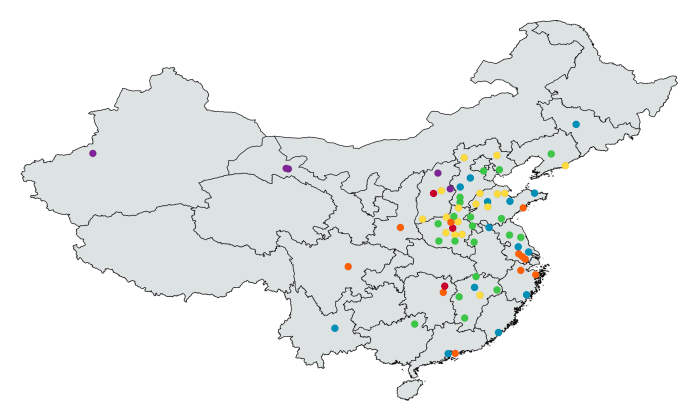
Note LinkTour, one of China’s key emerging manufacturers of affordable EV models, is targeting lower-tier cities for its dealerships.
Conclusion
Multiple factors still cloud the future of LSEVs in China (and other regions), as well as their potential to disrupt oil markets. There are a few things to consider:
- Even the best batteries cannot compete with the energy density of gasoline.
- Battery life remains a concern.
- Charging in public places remains a challenge.
- Will prospective car buyers in larger Chinese cities opt for LSEVs/Mini-EVs?
- An enterprising manufacturer that branched into small gasoline-powered vehicles at a price point under $10,000 could cannibalize market share that might have otherwise gone to LSEVs.
- Prospective drivers in areas that have not imposed restrictive regulations and punitive fees may decide that they are better off with a used gasoline engine vehicle.
- Driver tastes might evolve, leading them to trade LSEVs for larger, gasoline-fueled vehicles. Alternatively, drivers might trade up to larger EVs rather than gasoline-powered cars.
- A surge of road construction in China and the emergence of a more American-style road trip culture might revitalize vehicle utilization and drive gasoline demand increases at a scale that even rapid EV penetration cannot offset. Alternatively, local governments might follow the lead of Beijing and Shanghai and favor EVs of all types through license plate auctions and lotteries and placing odd/even day limits on driving gasoline-powered cars.
- LSEVs’ and other alternative fuel vehicles’ erosion of oil products demand creates a dynamic feedback loop whereby lower oil prices stimulate renewed consumption growth.
And so forth. But the fact that LSEVs in China have thus far been the only EVs worldwide that have successfully sold at industrial scale without unsustainable levels of government financial support suggests that they are a wild card worth watching. This is particularly true given China’s outsized importance as the global “oil consumer of last resort,” as well as the fact that if LSEV manufacturing capacity scales up in China, manufacturers are likely to begin targeting export markets in Africa, India, and Southeast Asia. These regions have many of the same characteristics as rural China in terms of no prior car ownership history and low income levels that often make “conventional” cars prohibitively expensive for most consumers.
Endnotes
1. “Disruptive innovation” occurs when smaller companies target consumer segments overlooked by larger, established firms. If these upstart firms successfully capture the lower-end consumer with cheaper, but still acceptable goods or services, they can then improve off this base and move upmarket. They are then positioned to directly compete in the large incumbent firms’ core markets, offer the goods or services demanded by more affluent consumers, and do so at a lower price and capture significant market share; Clayton M. Christensen, Michael E. Raynor, and Rory McDonald, “What Is Disruptive Innovation?” Harvard Business Review, December 2015, https://bit.ly/1HT2VUc.
2. Jinpeng Gao, Daniel Sperling, Yunshi Wang, and Gil Tal, “Low-speed Electric Vehicle Market Boom in China: (poster, University of California, Davis, December 2017), https://bit.ly/2Y9pHR5; Trefor Moss, “China’s Giant Market for Really Tiny Cars,” The Wall Street Journal, September 21, 2018, https://on.wsj.com/2NvKaiq.
3. “Global EV Outlook 2018,” The International Energy Agency, June 2018, https://bit.ly/2VlxwpW.
4. Nathaniel Bullard and Colin McKerracher, “Dispelling the Myth of China’s EV Market,” Bloomberg, February 8, 2019, https://bloom.bg/2MUtUnz.
5. Chandraseka Iyer, “Tesla’s China factory and the missed growth opportunity,” TechCrunch, January 2019, https://tcrn.ch/2GpC9s0.
6. Jonathan Xavier Weinert, “The Rise of Electric Two-wheelers in China: Factors for their Success and Implications for the Future,” (Ph.D. diss., University of California, Davis, 2007).
7. Dustin K. Crawford, “Alternative Practices to Improve Surface Fleet Fuel Efficiency,” (master’s thesis, Naval Postgraduate School, 2014).
8. Yongha Park and Morton E. O’Kelly, “Fuel burn rates of commercial passenger aircraft: variations by seat configuration and stage distance,” Journal of Transport Geography 41 (December 2014): 137-147, https://bit.ly/2YbxPki.
9. “Oil Market Report,” The International Energy Agency, March 15, 2018, https://bit.ly/2Jl3MT6.
10. Steve Loveday, “Monthly Plug-In EV Sales Scorecard,” InsideEVs, May 3, 2018, https://bit.ly/2VNEcwq.
11. Gabriel Collins, “China Peak Diesel Poses a Serious Challenge to Saudi Arabia, May Help Force OPEC Production Cut,” China SignPost™ (洞察中国), April 5, 2016, https://bit.ly/1SyKXWe.
12. “Statistical Review of World Energy,” BP, 2017, https://on.bp.com/2GSwdEa.
13. Gabriel Collins, “China’s Evolving Oil Demand Slowing Overall Growth, Gasoline Replacing Diesel as Demand Driver, Refined Product Exports Rising Substantially,” Baker Institute Working Paper, September 30, 2016, https://bit.ly/2H1zWA7.
14. See, for instance: Yang Jiang, Peiqin Gu, Yulin Chen, Dongquan He, and Qizhi Mao, “Influence of land use and street characteristics on car ownership and use: Evidence from Jinan, China,” Transportation Research Part D: Transport and Environment 52, Part B (May 2017): 518-534, https://bit.ly/2VfCCUC; Boqiang Lin and Wei Wu, “Why people want to buy electric vehicle: An empirical study in first-tier cities of China,” Energy Policy 112 (January 2018): 233-241, https://bit.ly/2V4g4RV.
15. Xiaofang Yang, Wen Jin, Hai Jiang, Qianyan Xie, Wei Shen, and Weijian Han, “Car ownership policies in China: Preferences of residents and influence on the choice of electric cars,” Transport Policy 58 (August 2017): 62-71, https://bit.ly/2DRGNv7.
16. Yang et al., “Car ownership policies in China,” 62-71.
17. Iyer, “Tesla’s China factory.”
18. Domenick Yoney, “Tesla Slashes Model 3, S & X Pricing in China: Up to $51,000 Less,” InsideEVs, March 1, 2019, https://bit.ly/2Y9q8uH; “YGM E-Cheng EV SUV,” WattEV2Buy, https://bit.ly/2Jl48Jq.
19. Chandresekar Iyer, “Driving Disruption: Catching the Next Wave of Growth in Electric Vehicles,” Christensen Institute, November 6, 2018, https://bit.ly/2ZSA5ym.
20. Yeon Baik, Russell Hensley, Patrick Hertzke, and Stefan Knupfer, “Making electric vehicles profitable,” March 2019, https://mck.co/2u3zcEI.
21. Fang Yan and Ken Willis, “Mini electric cars fill gap in China as official EVs splutter,” Reuters, April 19, 2012, https://reut.rs/3002PWc.
22. Gabriel Collins, “China’s Gasoline Demand Growth: Is Recent Deceleration Near-Term Noise or Early Stages of a Structural Shift?,” Baker Institute Research Presentation, March 2019, https://bit.ly/2IZGfYg.
23. Distance assumption derived from Feiqi Liu, Fuquan Zhao, Zomgwei Liu, and Han Hao, “China’s Electric Vehicle Deployment: Energy and Greenhouse Gas Emission Impacts,” Energies 11, no. 12 (2018): 3353, https://bit.ly/2H66v12.
24. “An Analysis of the Development and Future Prospects of China’s New Energy Vehicle Industry” (我国新能源汽车行业 发展水平分析及展望), Beijing Institute of Technology Energy & Environment Research Centre, 13 January 2019, https://bit.ly/2H5g14u.
25. “China’s New Energy Vehicle Industry,” Beijing Institute of Technology Energy.
26. Matt Slater, “China City Tiers—An Overview,” China Checkup, May 31, 2018, https://bit.ly/2Jm5Wls.
This material may be quoted or reproduced without prior permission, provided appropriate credit is given to the author and Rice University’s Baker Institute for Public Policy. The views expressed herein are those of the individual author(s), and do not necessarily represent the views of Rice University’s Baker Institute for Public Policy.



